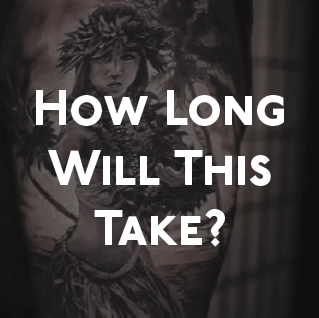
April 20, 2023
Timeframes: How Long Will My Tattoo Take?
This is a question we get asked all the time. And sometimes, the answer is question surprising. There are many factors which come into play when thinking about the timeframe of a tattoo. If you’re on a budget, and you really want to get some ink, consider some of these factors when choosing a design!
The Tattoo Size and Detail in Relation to Timeframe
The most obvious factor when it comes to the length of a tattoo session, is the size of the design. Obviously, the bigger the design, the more time the artist needs to do the piece. But, sometimes, a tattoo the size of a brick could take longer than a piece which covers half your forearm. This has to do with several different elements of your tattoo. The first, is level of detail. The finer details, the more slowly your artist needs to move. In tattoos like portraits or geometrical patterns, for example, one mess up can lead to a massive impact on the entire appearance of your tattoo. Therefore, your artist needs to move slower to concentrate on the details and execute the tattoo with precision.
Color vs. Black and Grey
Another significant factor in the timeframe of your tattoo is color. Color is an extremely lengthy process. The more colors your tattoo needs, the longer it will take. There are two many reason for this. The first is, color covers more surface area than linework. If every outline needs to be filled in with color, it will take more time. This is true for a blackwork pieces as well. If there are big spaces being filled with ink – its going to take more time.
The second reason for length extension is the number of colors used. For each color, your artist will need to clean their machine to ensure there’s no ink color left to avoid unwanted mixture of color. So, if you have a tattoo with 6 different colors, your artist needs to clean their machine each time they need to use a different color. This is a length process and can prolong your sitting.
Body Parts, Your Pain Tolerance in Relation to Timeframes
Your body and your pain tolerance play a factor into the timeframe of a tattoo. For obvious reasons, your pain tolerance can affect how long it takes to tattoo you. This doesn’t just include your ability to tolerate the needle – but also your comfort level in the position you need to be in. For example, hunching over so your tattoo artist can do a piece on your back may be more painful than sitting in a chair while they tattoo your ankle. How your body tolerances the position you need to be in can prolong how long it takes. If you need several breaks because it’s an unnatural position or because the tattoo hurts, then it will slow down the process.
In addition, the location of where you want to place the tattoo affects timeframes. If you get a piece done on your arm, it has easier access to than the inside of your thigh. If the spot is harder for your artist to reach and maneuver, than the session could take longer.
Artists’ Experience & Natural Ability
The last factor that plays a big role in the timeframe of your tattoo is your artist. An apprentice may move slower than a seasoned artists because they haven’t had enough experience to move quickly through a tattoo. They are learning and experiencing new skin types every day – and this can slow them down.
The more experience an artist has, the more likely they will move a little faster. In addition, if you’re doing a common subject matter – like roses or skulls, your artist has probably done hundreds of them. Therefore, they are going to move faster because they understand how the tattoo works and functions on skin. This can be applied to reusable flash designs as well. It is likely your artist has done them several times and knows what to expect. Doing designs an artist hasn’t yet drawn, could slow down the process as they familiarize themselves with how the design flows on your body.
Lastly, your artists natural ability can affect the time of your piece. Some artists move slower than others. This doesn’t mean they are less skilled, just that they work a little differently.
Moving Forward with Your Tattoo
Now that you have a base understanding of the attributes which affect timeframes of tattoos, you can start to get an understanding of how long your tattoo will take. Simple, limited detailed designs are going to take less time than a full realism sleeve. Always go in with an open mind as every artist is different. The more experience your artist has, the more likely their judgement on timeframes will be accurate – but always remember you have an effect on the length as well!
